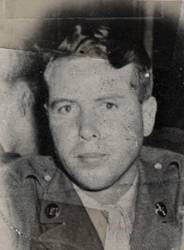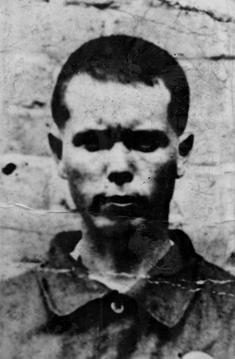
Norace in Manila (circa 1941)
Norace Whitecotton and his
twin
brother Horace were born in Seminole, Oklahoma on August 23, 1917. They lived outside of Shawnee, Oklahoma and
attended the local grade school, graduating from eighth grade in 1931.
Shortly after FDR announced the military draft, they registered for the draft, and rather than wait decided to enlist in the Army. They were offered assignment to either Panama or the Philippines. They both selected the Philippines. After their February swearing-in, they were loaded on the USS Republic for the 21-day transit to Corregidor. Then, after completing boot camp, they were assigned to C Battery, 60th Coast Artillery Regiment (Anti-Aircraft).
With war raging across Europe, FDR alerted military units to the potential of the United States entering the war very soon. As a result, preparations to defend Corregidor began in earnest around late August. By November, all Philippine fighting units had moved out of the garrison to the field. On Corregidor, C Btry, 60th CA Regt. (AA) was assigned to Morrison Hill.
The Japanese Philippine invasion under General Homma, focused on Manila, Nichols Field and Cavite through most of December, but after substantial success, on December 29th, the four-month siege of Corregidor began. By April, Corregidor was one of the last remaining defensive positions left in the northern Philippines Islands; thus allowing the Japanese army under General Homma, to launch an intense barrage of 105mm, 155mm, and 240mm artillery from the recently fallen Bataan peninsula combined with unrelenting aerial bombardment. Under extreme duress with no relief in sight, General Wainwright was forced to announce the surrender of Corregidor on May 6th.
Following that surrender, dad and his twin bother, along with over 10,000+ defenders of Corregidor, began their long ordeal as Japanese POWs. Dad’s first stop was Bilibid prison; however, that was short-lived as they were quickly packed in boxcars and shipped to the central POW camp of Cabanatuan.
In the melee that followed the surrender, Dad lost touch with his twin but they were reunited after arriving at Cabanatuan Camp #3. Fortunately, they were in the same prison camp but assigned to different barracks. In November, Horace and the rest of the men in his barracks, where shipped to Palawan Island. About that same time, Dad was shipped back to Bilibid prison. Special Note: Sadly, dad never saw his twin brother Horace ever again. He was murdered in The Massacre of Palawan Island in December 1944.
During the ensuing months, dad was moved to other POW camps like Nielson Field, and Zablon Field based on Japanese army work force needs. Then, on August 20, 1944, dad boarded the Hell Ship Noto Mura, where he spent 8 miserable days sailing to Moji, Japan. After arriving, everyone was suffering from the lack of food and water, poor sanitary conditions on the ship, and most suffered from heat rash. Yet, they were immediately put on a train to Mukaishima Island, which is located about 30 miles east of Hiroshima. That is where dad would spend the next year, until liberation, working mostly at the docks repairing ships or the smelter making cast iron wheels.
Shortly after the Atomic bombs were dropped on Japan, the guards started leaving, most were hoping to find their families still alive. At that point, all the POW’s ceased working and spent most of their time sitting around the camp or taking the water shuttle to the city of Mukaishima.
On September 16, 1945, Red Cross representatives came into the camp and told them to go to Mukaishima City and board the train to Yokohama. When the train had almost reached Yokohama, it suddenly pulled to a stop. Everyone was told to disembark and line up. On an adjacent track, another train had also stopped, senior officers, Generals MacArthur and Wainwright included, exited the train and commenced shaking every hand and thanking each of them for their service.
Upon arriving in Yokohama and after being examined by doctors, they were shuttled off to a C-54 for the long trip back to the United States. After extensive medical examinations and care, Dad was eventually discharged at Fort McArthur on November 16th.
As a child, I knew my dad had been a POW but that was pretty much the extent of it. My father rarely spoke about his experiences. Then some years after retiring, he was determined to write “his story.” During many visits, he would show me his most recent effort. Strangely, each attempt started trailing off at about the same time period such that none were ever completed.
Then in 2002, I suggested that he simply record his story on cassette tapes and mail them to me; whereupon, I would transcribe them into a story line. He sent me many cassette tapes and I dutifully transcribe them into a document. I would periodically send the printed documents to him for review and comments, until finally, we had his entire POW timeline and story documented. This effort, really sparked my interest, so I started researching the history of WWII in the Philippines, Palawan, and the Hell Ships, which ultimately led me to the Japanese-pow website.
During my research, I met several people (electronically) like Lorna Murray, who provided information on the Palawan Massacre, as her father was one of the few survivors. I also met Karol Ames, whose father, Capitan Godfrey Ames, was the commanding officer of Battery C. She provided his Narrative Report and diary, detailing combat events beginning November 1, 1941 through their surrender in 1942. These documents were helpful in verifying both events and dates. I Met Vern Holm, whose father also served in Chicago Battery and spent some time on Palawan Island. Vern sent me excerpts from his father’s diary and some then recent pictures of Corregidor.
All of these documents, diaries, pictures, etc. contributed to the creation of a self-published book “his story.” Dad was able to share many copies of the book with family and friends all with great fanfare after regaling them with of some of his stories.
I will say that after virtually no discussion about his war experiences for so many years, dad made up for this deficiency starting in his 80th year. He was fortunate to live in a community that appreciated his sacrifice and he was invited to speak at many public events. After so many years of silence, it was a joy to see him in “his spotlight.”
I always considered myself fortunate that dad survived this horrific ordeal. Many Japanese POW descendants were not so fortunate. I also considered myself fortunate that dad finally broke the silence and communicated his experience. I’m certain that some life events can be so traumatic that only time allows the mind to process them into something that doesn’t dredge up old feelings and emotions.
To the very end, dad never had a bad word to say about Japanese people – just maybe some of the guards, who took too much pleasure from the situation.
Dad passed away in 2009 shortly after his 92nd birthday. Dad had a wonderful life, which did not have such an auspicious beginning, yet “his story” continues to be heard even to this day. His great grandchildren often ask for a copy of his book, so they can write about him and present in their school. One final fact, I ran into a high school friend last month, and he commented that he picks up his copy of the book every so often to reread sections, and he added that he still finds it both interesting, intriguing, and enlightening. It’s comforting to know that “his story” is a legacy, which will be carried forward for generations to come.

Norace (circa 1945)–
Mukaishima Island, Japan